Regional Development Assessment and Policy Perspectives on Urban Residential Energy Efficiency Program in Morocco by 2030
Abstract
1. Introduction
1.1. General Appraisal
1.2. Energy Efficiency Policy Framework
1.2.1. Morocco’s Final Energy Consumption in the Building Sector
1.2.2. National EE Strategy
1.2.3. EE Strategy (Building Sector)
- -
- Zone 1 (Agadir): Coastal, mild winters, hot summers.
- -
- Zone 2 (Tangier): Mediterranean with mild humidity.
- -
- Zone 3 (Fes): Continental, hot summers, cold winters.
- -
- Zone 4 (Ifrane): Mountainous, cold winters.
- -
- Zone 5: Inland, dry hot summers.
- -
- Zone 6: Arid desert-like zones.
1.3. Literature Review
- -
- To quantify energy and economic gains from RTCM implementation across six climatic zones.
- -
- To compare conventional vs. RTCM-compliant construction for three building types.
- -
- To calculate investment payback periods.
- -
- To provide policy recommendations based on simulation outcomes.
2. Materials and Methods
2.1. Methodology
- -
- Characterizing the climatic conditions.
- -
- Detailing all components of the building envelope within the chosen case study.
- -
- Providing specifications for equipment within the building.
- -
- Utilizing the RTCM and conventional building models to compute thermal comfort and evaluate the value-added of RTCM.
- -
- Employing three-dimensional modeling and simulation techniques to analyze the building’s performance over the course of a year.
- -
- Conducting a comprehensive study on energy and economic savings.
- -
- Conventional construction.
- -
- Construction compliant with Moroccan thermal regulation conditions.
- -
- Evaluation of both construction scenarios for three building architectural types:
- -
- Villas.
- -
- Apartments.
- -
- Modern Moroccan houses.
2.2. Technical Data and Hypothesis
Building Envelops and Characteristics
2.3. Simulations Parameters and Consideration
2.4. Mathematical Models
2.4.1. Thermal Model
- dT/dt: Rate of change in air temperature over time.
- Tamb: Ambient temperature.
- T: Temperature inside building.
- U: Wall surface transmission coefficient.
- A: Total area of the walls.
- Cpair: Specific heat capacity of air.
- Qgains: Sum of internal and external heat gains, such as solar gains, electrical appliances, etc.
- Cap: Thermal capacity of the material or mass being heated.
- : Mass flow rate of air entering the building.
- : flow rate of air infiltrating the building.
- Tvent: Temperature of the air entering the building.
- Tinf: Temperature of the air infiltrating the building.
- : Rate of change in humidity over time within the space.
- : Mass flow rate of air infiltrating the building.
- ρ: Density of air.
- V: Volume of the building.
- : Humidity ratio inside the building.
- : Humidity ratio of the air infiltrating the building.
- : Mass flow rate of air entering the building.
- : Humidity ratio of the air entering the building.
- : Sum of humidity ratio gains, including internal and external sources.
2.4.2. Economic Data and Hypothesis
2.4.3. Electric Energy Avoided
2.4.4. Payback Time
3. Results and Discussion
3.1. National Energy Assessment
3.1.1. Cooling and Heating Demand
3.1.2. Total Energy Demand
3.1.3. Final Energy Savings
3.1.4. Primary Energy Savings
3.1.5. Electrical Energy Avoided
- -
- Villas: The TR measures lead to an average reduction of 5000 Wh in power consumption for villas. This reduction signifies a substantial decrease in the power requirements for heating and cooling systems in these larger residential structures.
- -
- MMHs (modern Moroccan homes): For MMHs, the average power reduction amounts to 3800 Wh. This demonstrates a significant decrease in the energy demand for climate control systems in this prevalent building type, which constitutes 63% of all building structures in Morocco.
- -
- Apartments: The TR measures result in an average power reduction of 2200 Wh for apartments. This signifies notable energy savings in these more compact and commonly found housing units.
3.2. Energy Bill Saving
3.3. Additional Costs
3.4. Payback Time
3.5. Previsions by 2030: The Efficient Future
4. Conclusions and Policy Implications
Author Contributions
Funding
Data Availability Statement
Conflicts of Interest
Abbreviations
| IPCC | Intergovernmental Panel on Climate Change |
| GHG | Greenhouse gas |
| NDC | National Determined Contribution. |
| AMEE | Agence Marocaine pour l’Efficacité Energétique |
| UNDP | United Nations Development Program |
| TR | Thermal Regulation |
| MMH | Modern Moroccan House |
| CC | Conventional Construction |
References
- Sarkis, J.; Tamarkin, M. Real options analysis for renewable energy technologies in a GHG emissions trading environment. In Emissions Trading: Institutional Design, Decision Making and Corporate Strategies; Antes, R., Hansjürgens, B., Letmathe, P., Eds.; Springer: New York, NY, USA, 2008; pp. 103–119. [Google Scholar] [CrossRef]
- Gielen, D. Global Energy Transformation: A Roadmap to 2050; IRENA: Masdar City, Abu Dhabi, 2018. [Google Scholar]
- International Energy Agency. Energy Policies Beyond IEA Countries: Morocco 2019; IEA: Paris, France, 2019. [Google Scholar]
- Switchmed. Morocco launches its National Framework Plan on SCP and two sectorial Plans on Sustainable Building and Sustainable Food. EU Neighbours South, 15 December 2016. [Google Scholar]
- PEEB_Morocco_Country Brief_Mar 2019. Available online: https://peeb.build/ (accessed on 1 March 2025).
- AMEE. Energy Efficiency in Buildings, 2020. Available online: https://www.amee.ma/en/node/118 (accessed on 1 March 2025).
- Ministère de la Transition Energétique et du Développement Durable. Stratégie Bas Carbone à Long Terme—Maroc 2050; MTEDD: Rabat, Morocco, 2021. [Google Scholar]
- Khatib, N. Country Profile—Morocco. 2018; RES4AFRICA: Rome, Italy, 2018. [Google Scholar]
- Ministère de l’Energie, des Mines et de l’Environnement. Stratégie Nationale de l’Efficacité Énergétique à l’Horizon 2030. Available online: https://www.mem.gov.ma/Lists/Lst_rapports/Attachments/33/Strat%C3%A9gue%20Nationale%20de%20l%27Efficacit%C3%A9%20%C3%A9nerg%C3%A9tique%20%C3%A0%20l%27horizon%202030.pdf (accessed on 1 March 2025).
- AMEE. Cadre Règlementaire. Available online: https://www.amee.ma/fr/cadre-reglementaire#:~:text=Il%20ne%20faut%20pas%20oublier,20%25%20d'ici%202030.&text=La%20loi%2013%2D09%20relative,'%C3%A9lectricit%C3%A9%20d'origine%20renouvelable (accessed on 31 October 2023).
- Walsh, A.; Cóstola, D.; Labaki, L.C. Comparison of three climatic zoning methodologies for building energy efficiency applications. Energy Build. 2017, 146, 111–121. [Google Scholar] [CrossRef]
- Saheb, Y. Modernising Building Energy Codes to Secure our Global Energy Future; IEA Policy Pathway Series 1; IEA: Paris, France, 2011. [Google Scholar]
- Xiong, J.; Yao, R.; Grimmond, S.; Zhang, Q.; Li, B. A hierarchical climatic zoning method for energy efficient building design applied in the region with diverse climate characteristics. Energy Build. 2019, 186, 355–367. [Google Scholar] [CrossRef]
- Verichev, K.; Zamorano, M.; Salazar-Concha, C.; Carpio, M. Analysis of climate-oriented researches in building. Appl. Sci. 2021, 11, 3251. [Google Scholar] [CrossRef]
- Cheng, C. Adaptation of Buildings for Climate Change: A Literature Review. Master’s Thesis, University of Gävle, Gävle, Sweden, 2021. [Google Scholar]
- Evola, G.; Gullo, F.; Marletta, L. The role of shading devices to improve thermal and visual comfort in existing glazed buildings. Energy Procedia 2017, 134, 346–355. [Google Scholar] [CrossRef]
- Alzoubi, H.H.; Malkawi, A.T. The optimal utilization of solar energy in residential buildings in light of the Jordanian building regulations. Sustain. Cities Soc. 2015, 14, 441–448. [Google Scholar] [CrossRef]
- Krarti, M.; Dubey, K. Energy productivity evaluation of large scale building energy efficiency programs for Oman. Sustain. Cities Soc. 2017, 29, 12–22. [Google Scholar] [CrossRef]
- Crawford, R.H.; Bartak, E.L.; Stephan, A.; Jensen, C.A. Evaluating the life cycle energy benefits of energy efficiency regulations for buildings. Renew. Sustain. Energy Rev. 2016, 63, 435–451. [Google Scholar] [CrossRef]
- He, B.; Yang, L.; Ye, M.; Mou, B.; Zhou, Y. Overview of rural building energy efficiency in China. Energy Policy 2014, 69, 385–396. [Google Scholar] [CrossRef]
- Mizgan, P.; Cirstolovean, I.L.; Tamas, F.-L.; Muntean, R.; Cazacu, C. Study on the Influence of Solar Contributions on the Total Energy Consumption for an Education Building. Procedia Eng. 2017, 181, 762–769. [Google Scholar] [CrossRef]
- de Abreu-Harbich, L.V.; Chaves, V.L.; Brandstetter, M.C.G. Evaluation of strategies that improve the thermal comfort and energy saving of a classroom of an institutional building in a tropical climate. Build. Environ. 2018, 135, 257–268. [Google Scholar] [CrossRef]
- Ning, H.; Wang, Z.; Ren, J.; Ji, Y. Thermal comfort and thermal adaptation between residential and office buildings in severe cold area of China. Procedia Eng. 2015, 121, 365–373. [Google Scholar] [CrossRef]
- Martínez-Molina, A.; Tort-Ausina, I.; Cho, S.; Vivancos, J.-L. Energy efficiency and thermal comfort in historic buildings: A review. Renew. Sustain. Energy Rev. 2016, 61, 70–85. [Google Scholar] [CrossRef]
- Baik, A.; Almaimani, A.; Al-Amodi, M.; Rahaman, K.R. Applying digital methods for documenting heritage building in Old Jeddah: A case study of Hazzazi House. Digit. Appl. Archaeol. Cult. Herit. 2021, 21, e00189. [Google Scholar] [CrossRef]
- Garcia-Ceballos, L.; de Andres-Díaz, J.R.; Contreras-Lopez, M.A. Life cycle study of different constructive solutions for building enclosures. Sci. Total Environ. 2018, 626, 1167–1174. [Google Scholar] [CrossRef]
- Li, Y.; Zhou, J.; Long, E.; Meng, X. Experimental study on thermal performance improvement of building envelopes by integrating with phase change material in an intermittently heated room. Sustain. Cities Soc. 2018, 38, 607–615. [Google Scholar] [CrossRef]
- Alam, M.; Devjani, M.R. Analyzing energy consumption patterns of an educational building through data mining. J. Build. Eng. 2021, 44, 103385. [Google Scholar] [CrossRef]
- Barnes, E.; Parrish, K. Small buildings, big impacts: The role of small commercial building energy efficiency case studies in 2030 Districts. Sustain. Cities Soc. 2016, 27, 210–221. [Google Scholar] [CrossRef]
- Pomfret, L.; Hashemi, A. Thermal comfort in zero energy buildings. Energy Procedia 2017, 134, 825–834. [Google Scholar] [CrossRef][Green Version]
- Soutullo, S.; Sánchez, M.; Enríquez, R.; Olmedo, R.; Jiménez, M.; Heras, M. Comparative thermal study between conventional and bioclimatic office buildings. Build. Environ. 2016, 105, 95–103. [Google Scholar] [CrossRef]
- Gargab, F.Z.; Allouhi, A.; Kousksou, T.; El-Houari, H.; Jamil, A.; Benbassou, A. A new project for a much more diverse moroccan strategic version: The generalization of solar water heater. Inventions 2021, 6, 2. [Google Scholar] [CrossRef]
- Ibáñez, M.; Lázaro, A.; Zalba, B.; Cabeza, L.F. An approach to the simulation of PCMs in building applications using TRNSYS. Appl. Therm. Eng. 2005, 25, 1796–1807. [Google Scholar] [CrossRef]
- Fritzsche, K.; Zejli, D.; Tänzler, D. The relevance of global energy governance for Arab countries: The case of Morocco. Energy Policy 2011, 39, 4497–4506. [Google Scholar] [CrossRef]
- Nowak, D.J.; Appleton, N.; Ellis, A.; Greenfield, E. Residential building energy conservation and avoided power plant emissions by urban and community trees in the United States. Urban For. Urban Green. 2017, 21, 158–165. [Google Scholar] [CrossRef]
- Asdrubali, F.; Ballarini, I.; Corrado, V.; Evangelisti, L.; Grazieschi, G.; Guattari, C. Energy and environmental payback times for an NZEB retrofit. Build. Environ. 2019, 147, 461–472. [Google Scholar] [CrossRef]
- Haut Commissariat au Plan. Prospective Maroc 2030. Available online: https://www.hcp.ma/downloads/?tag=Prospective+Maroc+2030 (accessed on 1 March 2025).
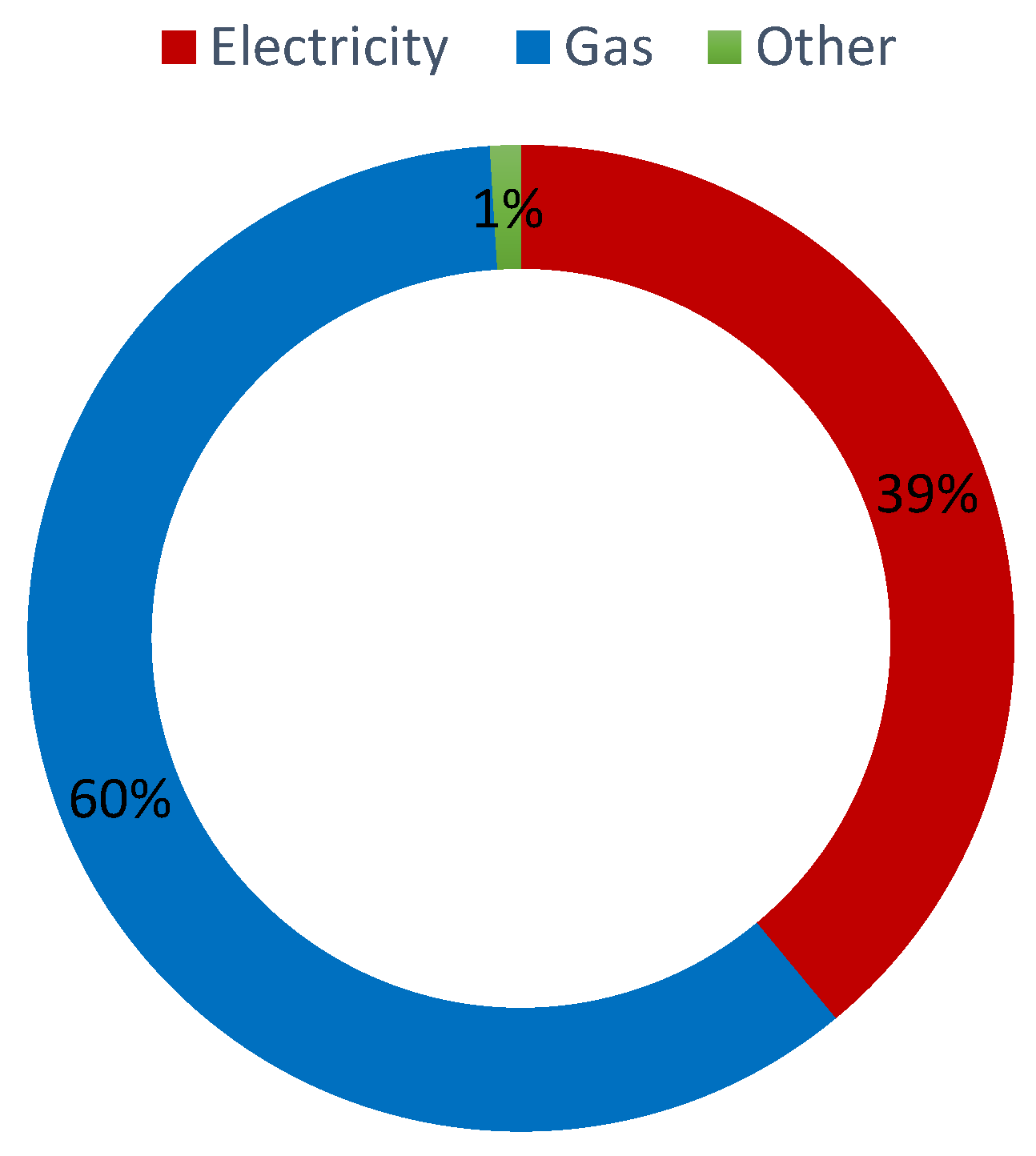
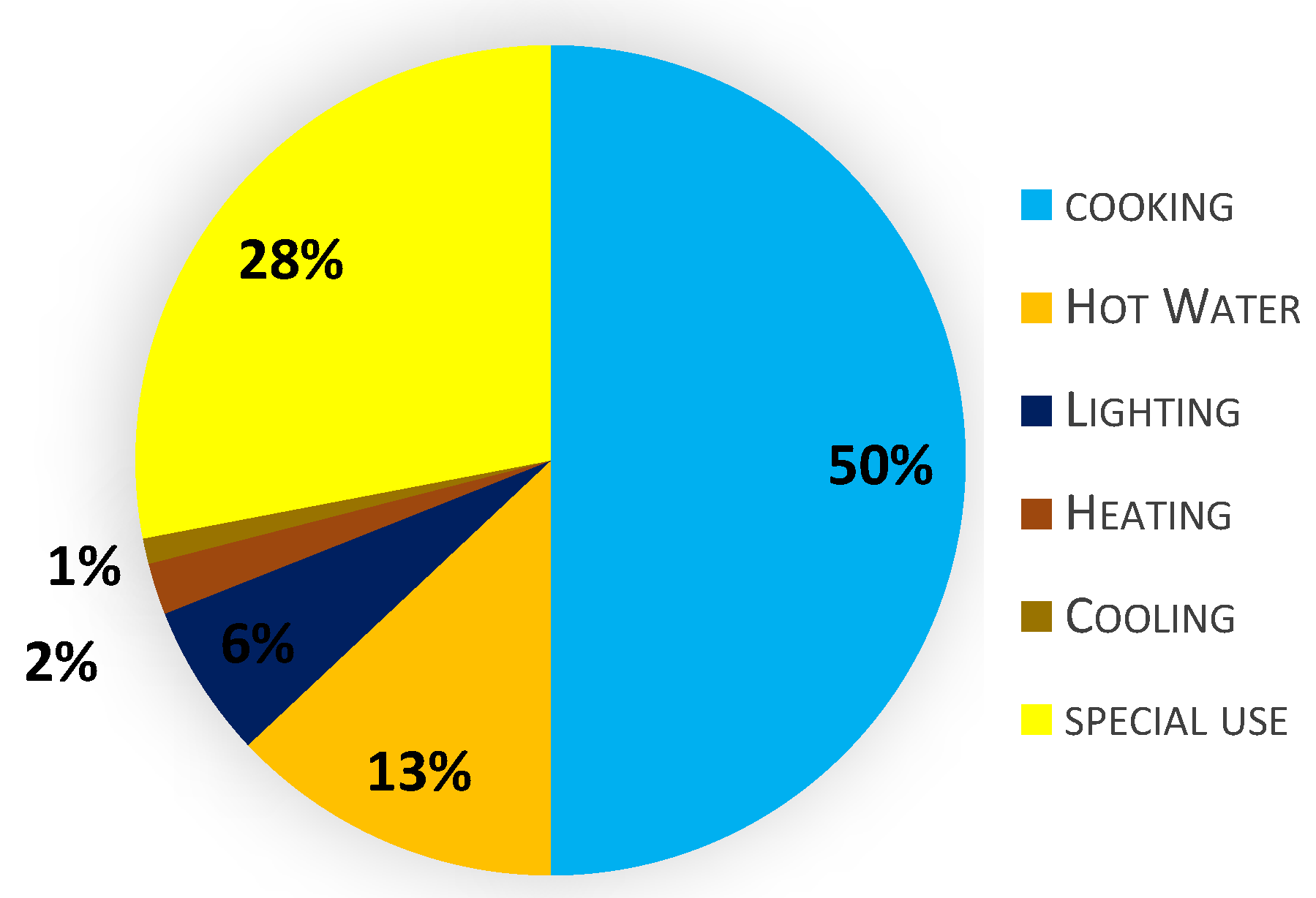

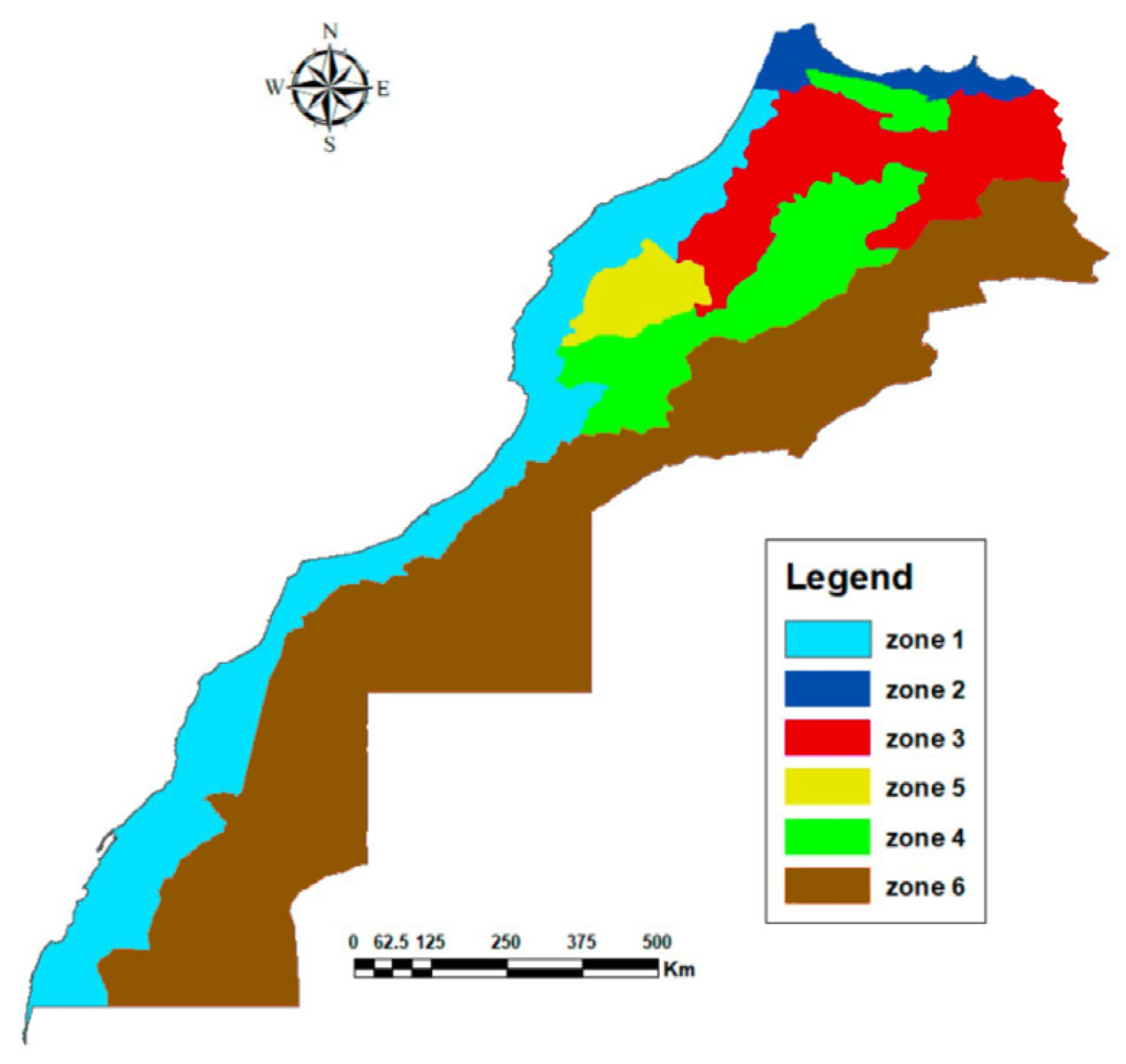



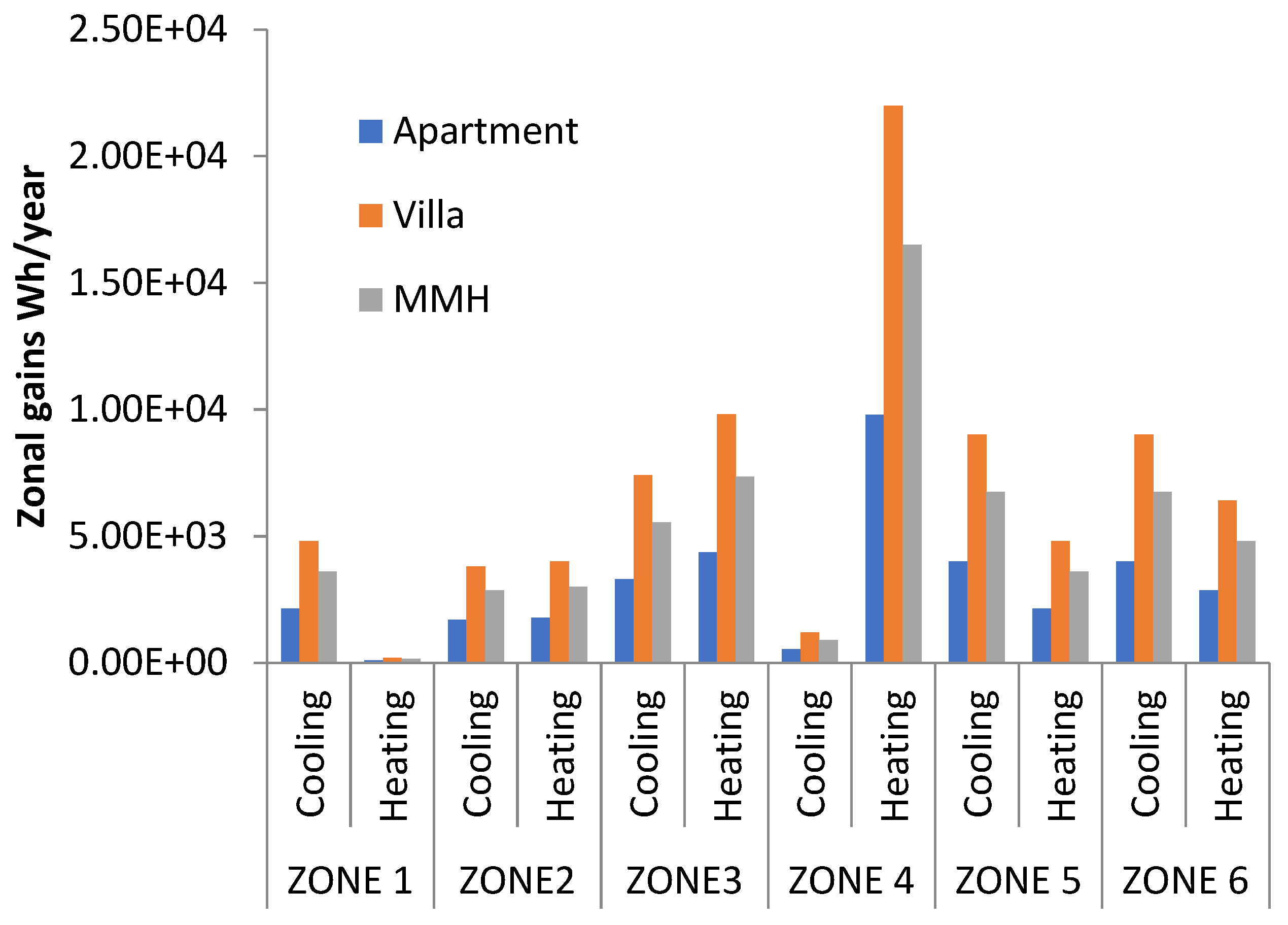

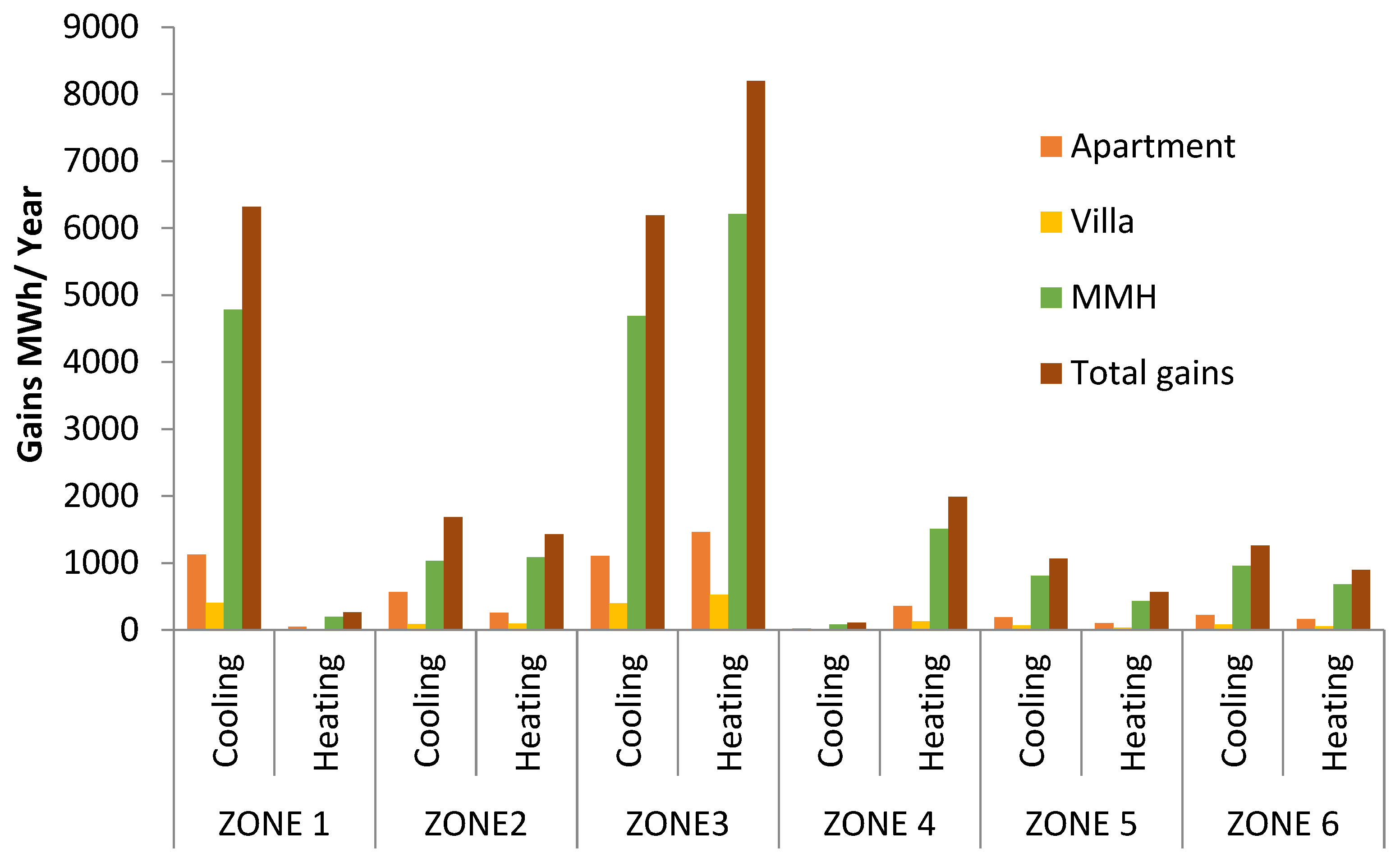

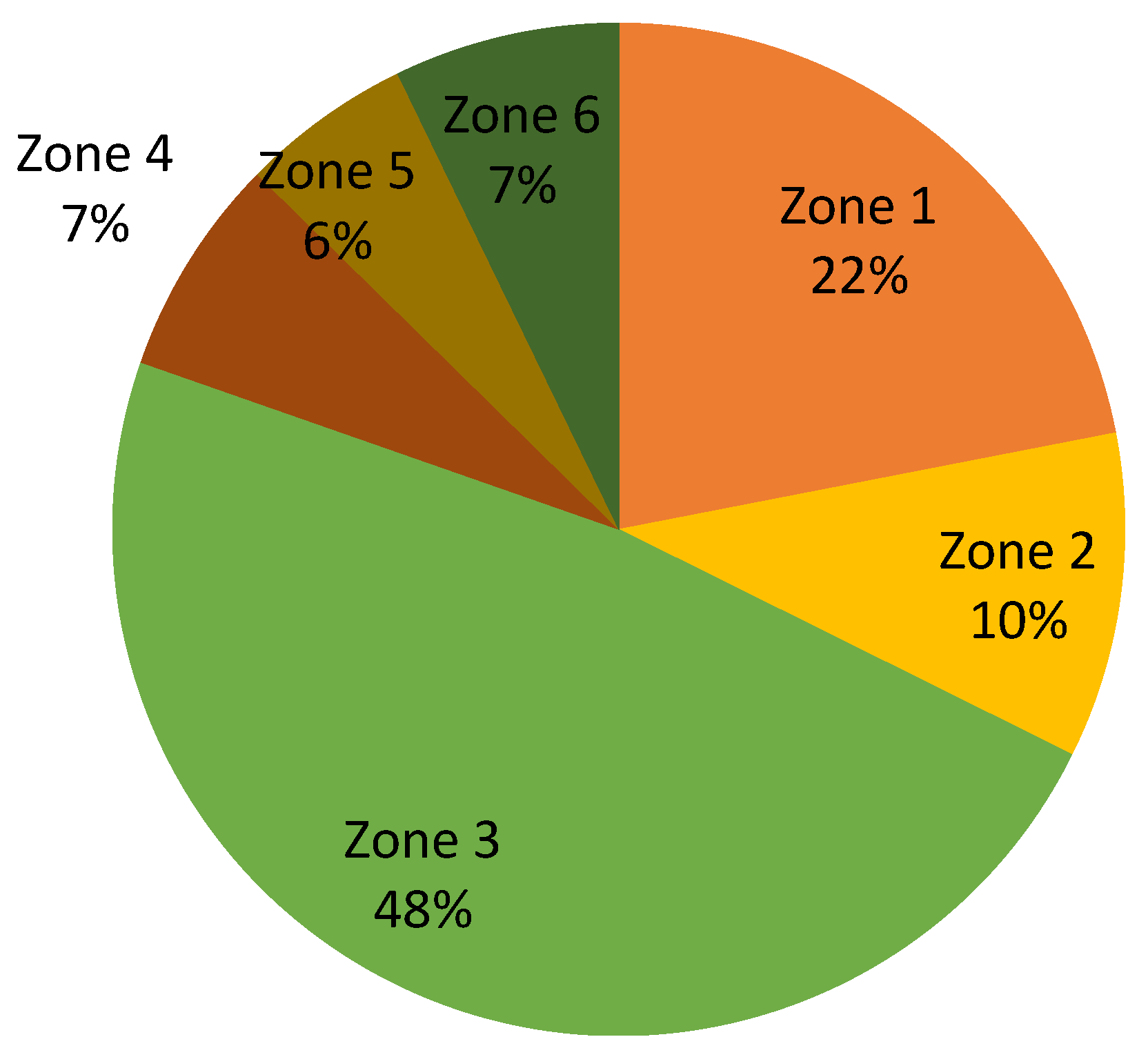


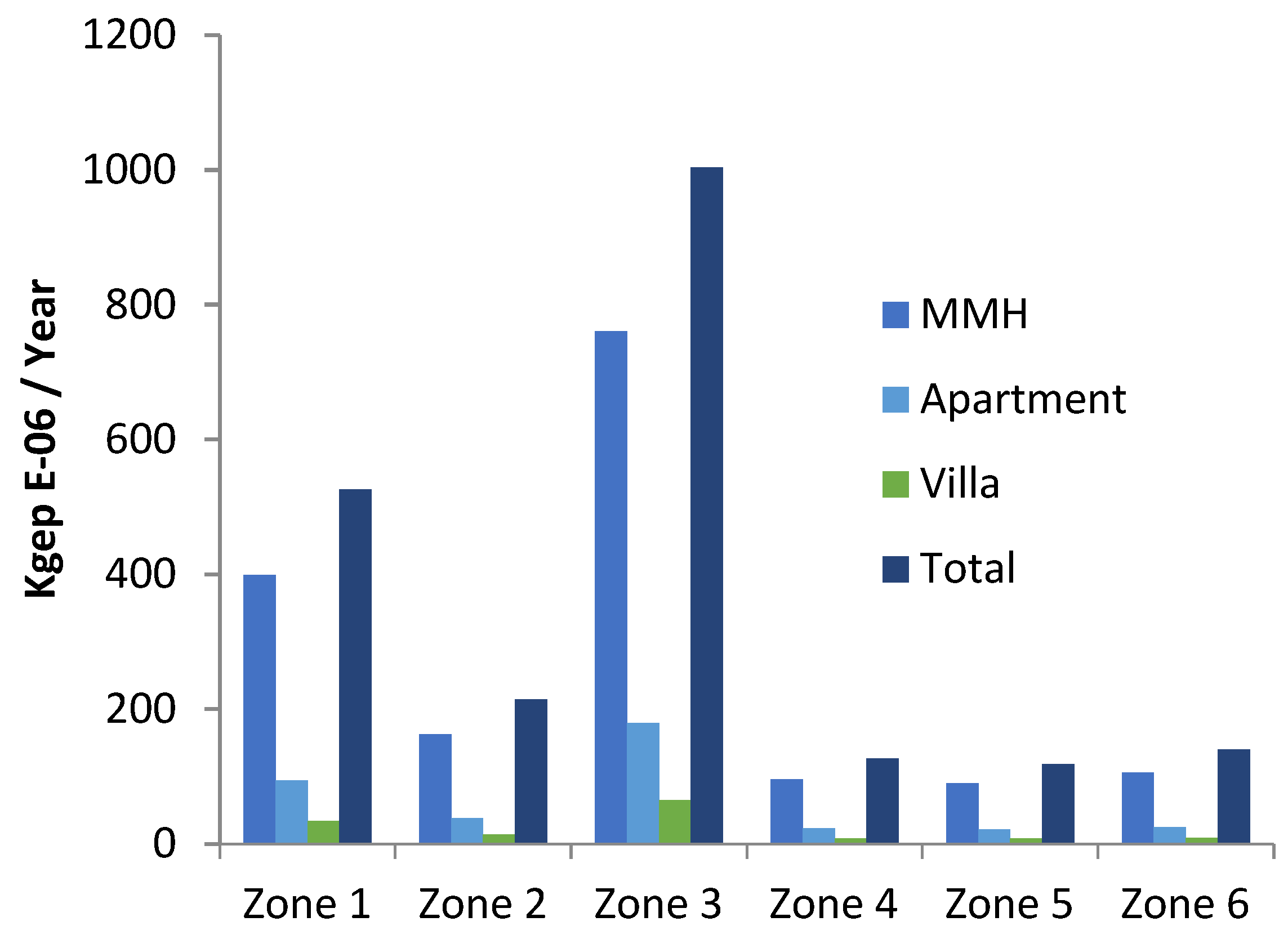
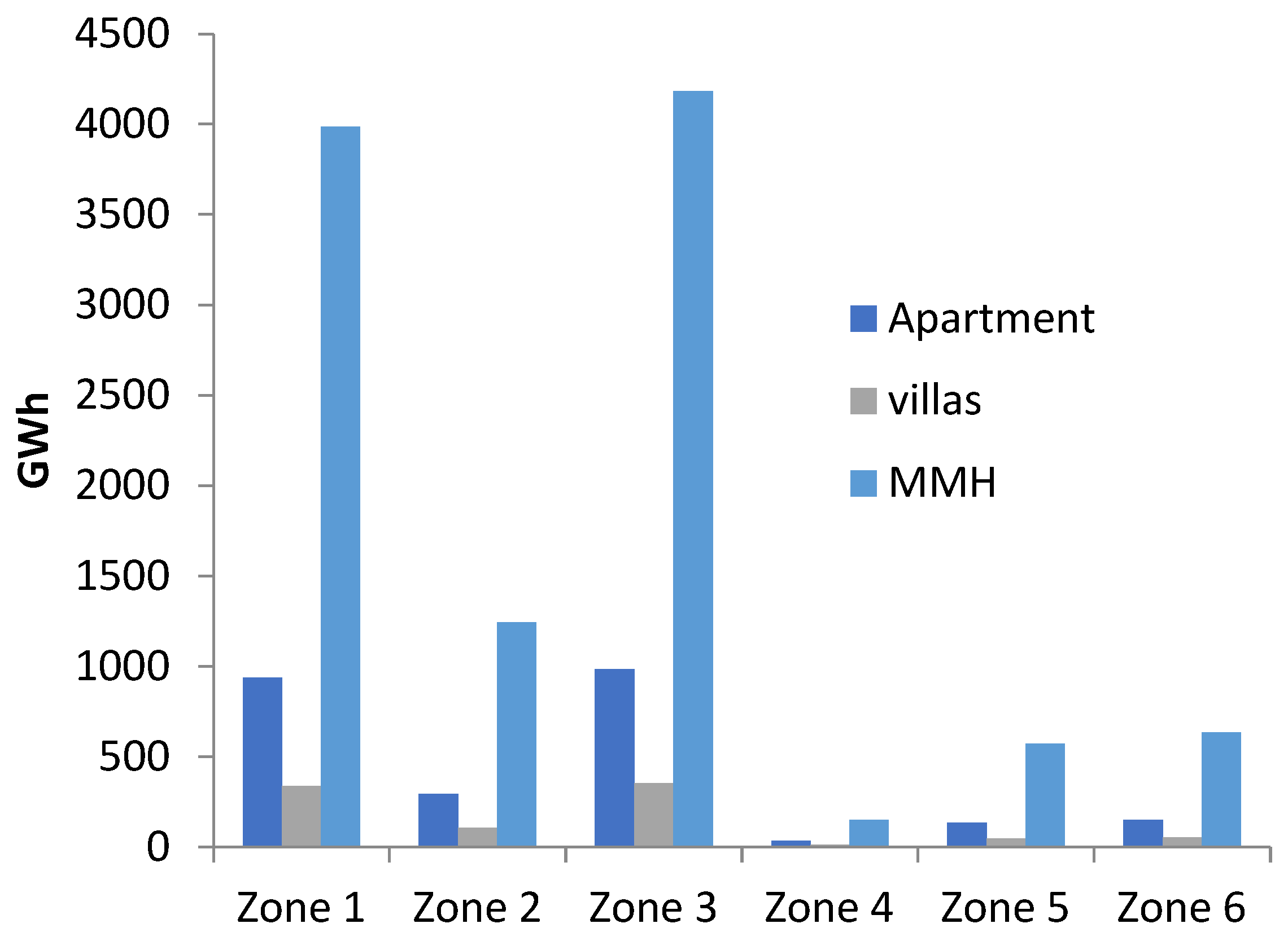

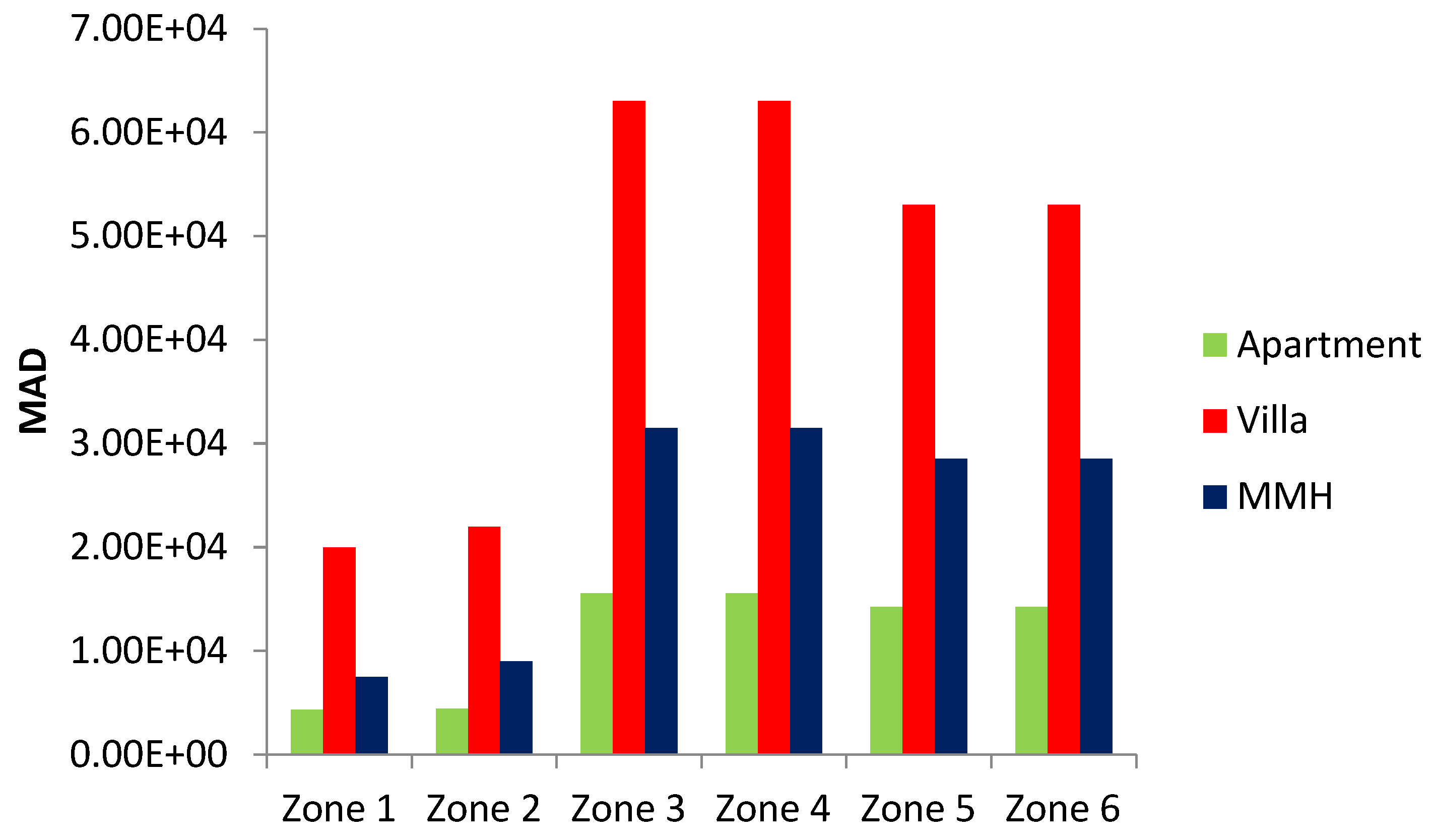
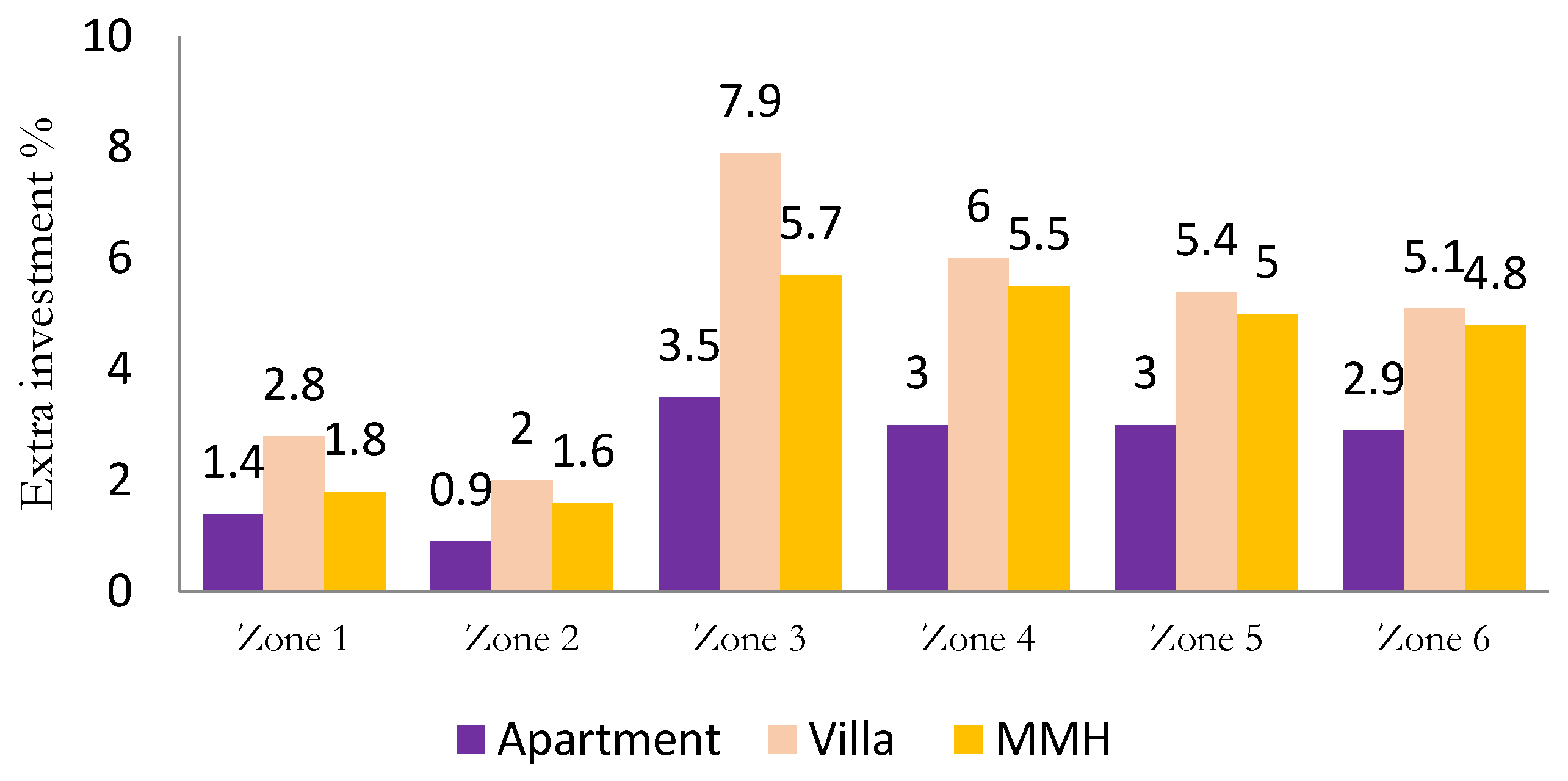
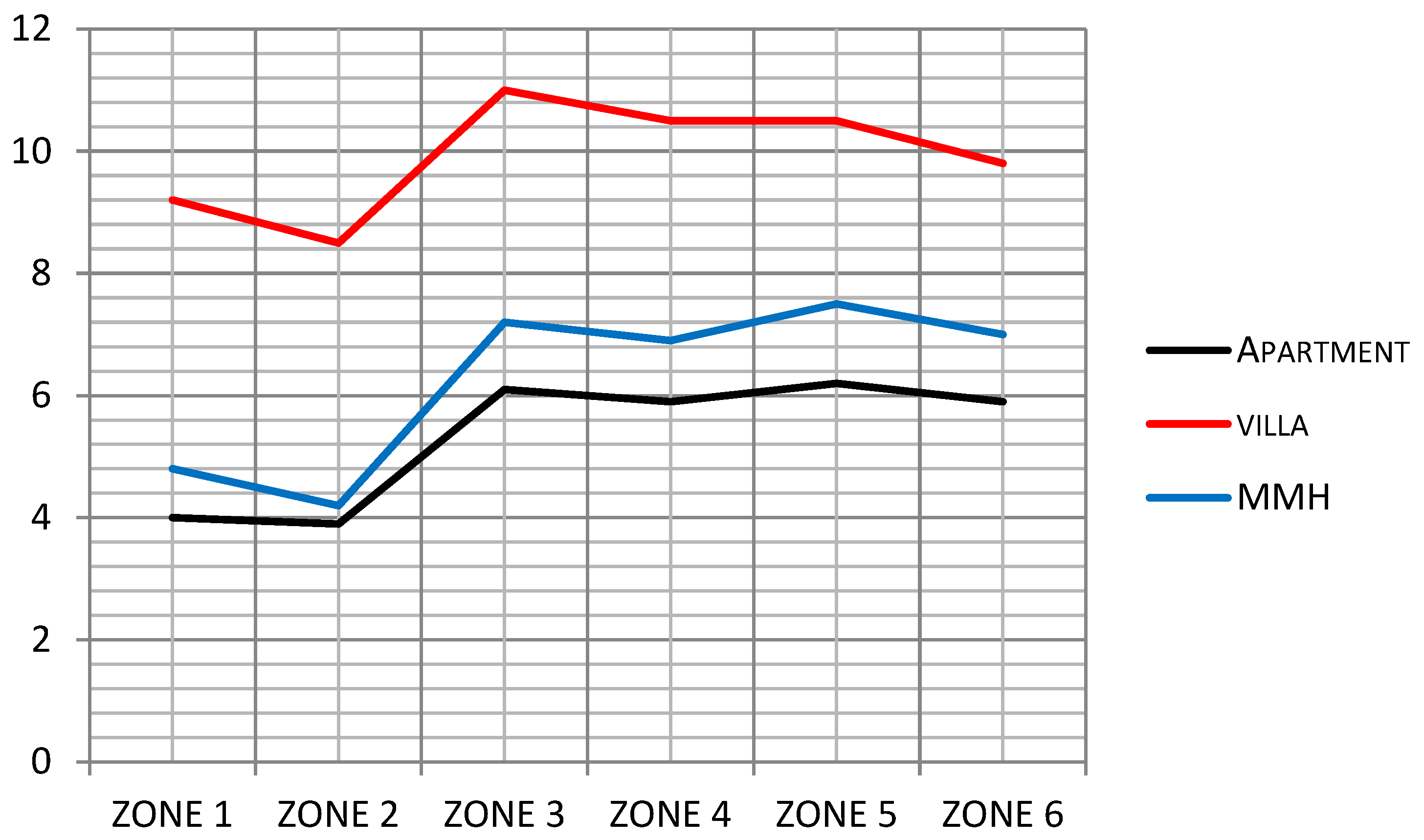
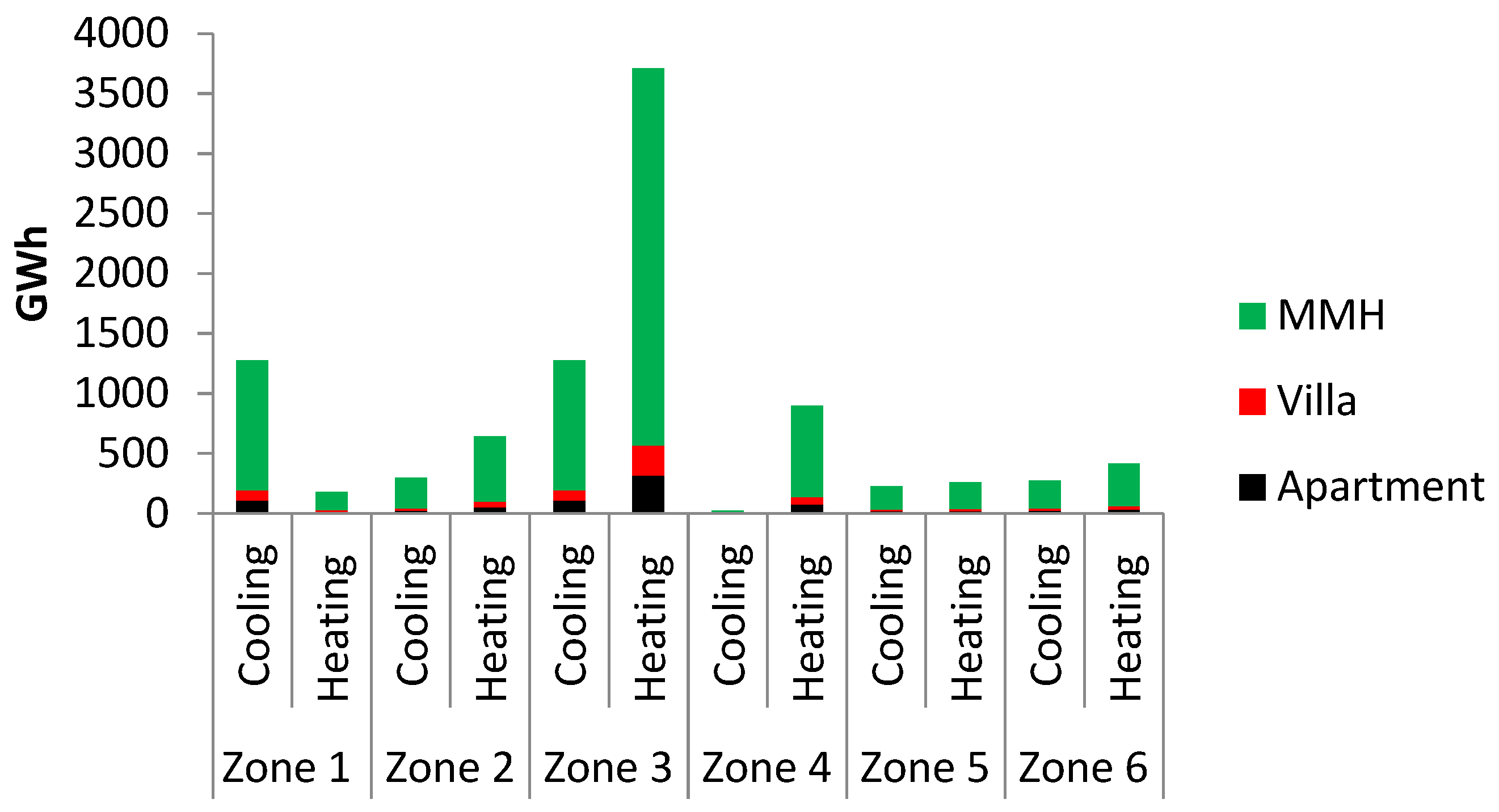
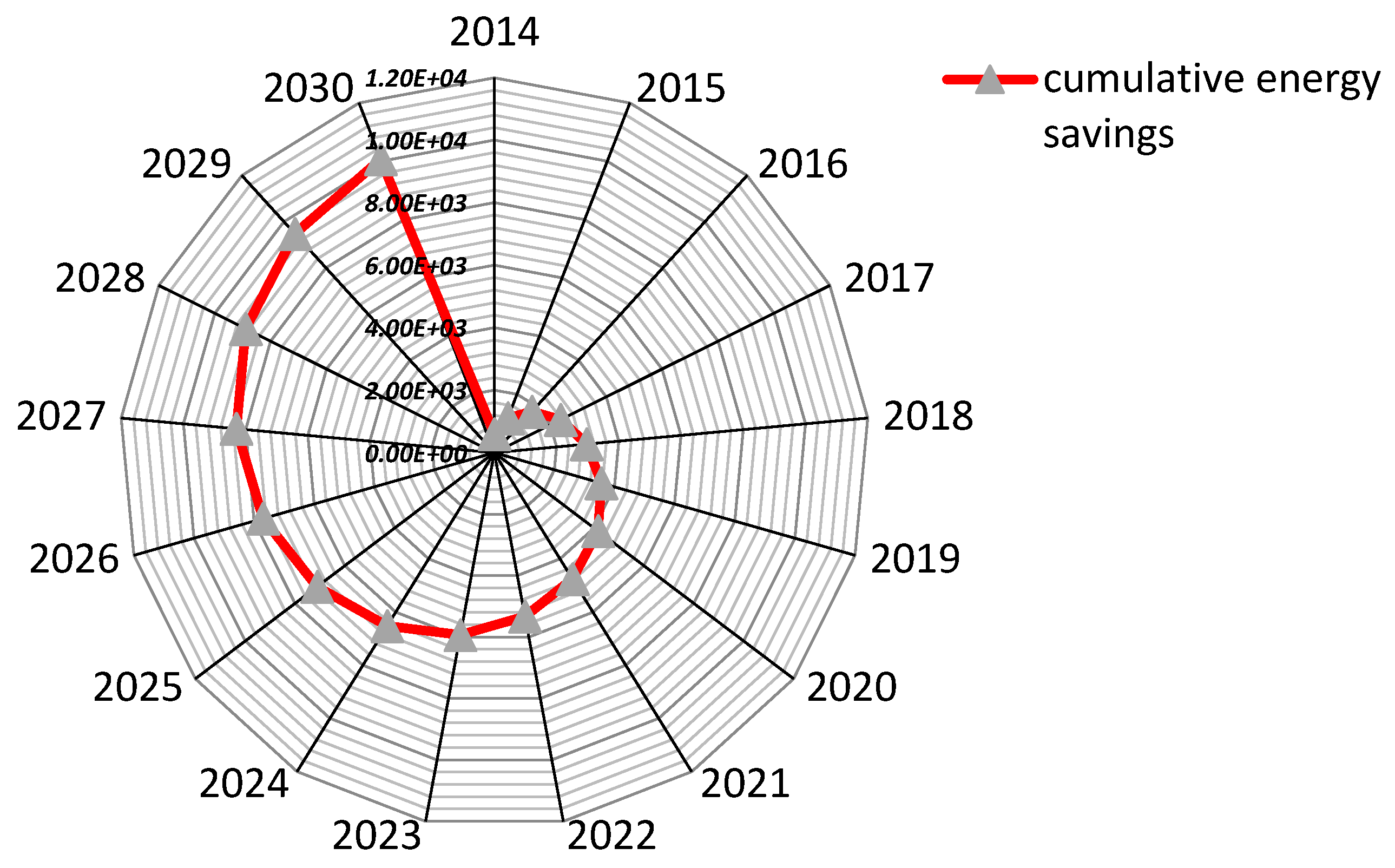
| Law Project | Description |
| Law No. 47-09 on energy efficiency, 2011 | It creates the framework for all economic sectors’ understanding of energy performance. It stipulates how to carry out the following:
|
| Law Nº. 47-09 Decree implementing 2015 General Construction Regulations governing buildings’ energy performance | Reducing the amount of heating and cooling that newly built homes and businesses require is the aim of this rule. For buildings with window-to-wall ratios of less than 45%, it applies a performance-based approach; for other buildings, it uses a prescriptive method. The building walls’ thermal transmission coefficients are the main focus of the technical requirements. The owner of the building must submit a technical sheet outlining the proposed structure’s thermal performance and proving compliance with regulations in order to obtain a construction permit. |
| No. 47-09 Decree project implementing law about the energy labeling performance thresholds for equipment | The statement stipulates that appliances and equipment sold within the national borders must comply with minimum performance and energy labeling criteria. For every single piece of machinery and appliance, a cooperative ordinance will specify the following:
|
| Law No. 47-09 Draft decree implementing energy impact studies | An obligation to evaluate the energy consequences of all new construction and urban development initiatives is included by the proposed decree. Planning for anticipated energy use and putting necessary changes into place in accordance with national energy and energy efficiency policies are the goals. The following components are included in the energy impact study:
|
| Norm NM 14.2.300 2012 standard for labeling appliances and domestic electrical goods | Equipment covered includes air-conditioners, refrigerators, freezers, and other cooling appliances; ovens for cooking; washing machines, dishwashers, and dryers; and domestic electric lamps, which can be either incandescent or fluorescent and have integrated ballast. In 2018, this standard was revised in conjunction with special standards 14.2.301 and 14.2.302 to more successfully execute the criteria for refrigerator and air-conditioner labeling, respectively. |
| Policy | Year | Status |
|---|---|---|
| Decree No. 927-20 on the mandatory use of Moroccan norms. | 2020 | In force |
| The mandatory energy audits and energy audit companies, Decree No. 2-17-746. | 2019 | In force |
| Program for energy-efficient public buildings. | 2019 | In force |
| Air-conditioner MEPS. | 2018 | In force |
| Contributions determined nationally (NDC) | 2016 | In force |
| MorSEFE | 2015 | In force |
| Decree No. 2-13-874 concerning building thermal regulation | 2014 | In force |
| Moroccan 14.2.300 Standard NM | 2010 | In force |
| Wall | Building Envelope | Thickness | Thermal Conductivity | Thermal Capacity | Density |
|---|---|---|---|---|---|
| cm | w/mK | kJ/kg K | m3/kg | ||
| Ground Floor (Vertical) | Concrete bricks | 20 | 1.15 | 1 | 1800 |
| Cement coating | 2 | 4.14 | 1 | 1700 | |
| Wall painting | 1 | 4.32 | 1 | 2000 | |
| Other Floors (Vertical) | 9-holes bricks | 20 | 6.516 | 0.878 | 1800 |
| Cement coating | 2 | 4.14 | 1 | 1700 | |
| Wall painting | 1 | 4.32 | 1 | 2000 | |
| Internal Ceiling | Ceramic | 10 | 4 | 1 | 1500 |
| Conventional concrete | 20 | 4.24 | 1 | 1800 | |
| External Ceiling | Ceramic | 10 | 4 | 1 | 1500 |
| Bitumen | 1 | 0.828 | 1 | 2000 | |
| Conventional concrete | 20 | 4.24 | 1 | 1800 | |
| Floor | Soft stones | 20 | 4.32 | 1 | 2000 |
| Tiles | 1 | 1.75 | 0.70 | 2300 | |
| Solid slab (concrete) | 20 | 9 | 1 | 2000 |
| Wall | Building Envelope | Thickness | Thermal Conductivity | Thermal Capacity | Density |
|---|---|---|---|---|---|
| cm | KJ/hmk | kJ/kg K | m3/kg | ||
| Vertical | 9-hole bricks | 20 | 6.516 | 0.878 | 1800 |
| Air gape | 20 | 0.6012 | 1.001 | 1.2 | |
| 3-hole bricks | 5 | 4.22 | 0.79 | 1700 | |
| Cement coating | 2 | 4.14 | 1 | 1700 | |
| Wall painting | 1 | 4.32 | 1 | 2000 | |
| Internal Ceiling | Ceramic | 10 | 4 | 1 | 1500 |
| Rockwool | 6.5 | 4.68 | 0.92 | 300 | |
| Conventional concrete | 20 | 4.24 | 1 | 1800 | |
| External Ceiling | Ceramic | 10 | 4 | 1 | 1500 |
| Rockwool | 6.5 | 4.68 | 0.92 | 300 | |
| Bitumen | 1 | 0.828 | 1 | 2000 | |
| Conventional concrete | 20 | 4.24 | 1 | 1800 | |
| Floor | Soft stones | 20 | 4.32 | 1 | 2000 |
| Cork plate | 10 | 0.14 | 0.48 | 120 | |
| Solid slab (concrete) | 20 | 9 | 1 | 2000 |
| WALL | he (W/m2 °C) | hi (W/m2 °C) |
|---|---|---|
| External vertical | 60.12 | 32.4 |
| Internal vertical | 32.4 | 32.4 |
| Ground floor | 21.24 | 21.24 |
| Internal ceiling | 72 | 72 |
| External ceiling | 72 | 39.96 |
| Year | 1912 | 2020 | 2030 |
|---|---|---|---|
| Average yield (%) | 38 | 40 | 42 |
| Equivalent of GWh (teq) | 220 | 212 | 205 |
Disclaimer/Publisher’s Note: The statements, opinions and data contained in all publications are solely those of the individual author(s) and contributor(s) and not of MDPI and/or the editor(s). MDPI and/or the editor(s) disclaim responsibility for any injury to people or property resulting from any ideas, methods, instructions or products referred to in the content. |
© 2025 by the authors. Licensee MDPI, Basel, Switzerland. This article is an open access article distributed under the terms and conditions of the Creative Commons Attribution (CC BY) license (https://creativecommons.org/licenses/by/4.0/).
Share and Cite
Gargab, F.Z.; Kaitouni, S.I.; Jamil, A.; Kasinathan, P.; Saadani, R.; Rahmoune, M. Regional Development Assessment and Policy Perspectives on Urban Residential Energy Efficiency Program in Morocco by 2030. Urban Sci. 2025, 9, 149. https://doi.org/10.3390/urbansci9050149
Gargab FZ, Kaitouni SI, Jamil A, Kasinathan P, Saadani R, Rahmoune M. Regional Development Assessment and Policy Perspectives on Urban Residential Energy Efficiency Program in Morocco by 2030. Urban Science. 2025; 9(5):149. https://doi.org/10.3390/urbansci9050149
Chicago/Turabian StyleGargab, Fatima Zohra, Samir Idrissi Kaitouni, Abdelmajid Jamil, Padmanathan Kasinathan, Rachid Saadani, and Miloud Rahmoune. 2025. "Regional Development Assessment and Policy Perspectives on Urban Residential Energy Efficiency Program in Morocco by 2030" Urban Science 9, no. 5: 149. https://doi.org/10.3390/urbansci9050149
APA StyleGargab, F. Z., Kaitouni, S. I., Jamil, A., Kasinathan, P., Saadani, R., & Rahmoune, M. (2025). Regional Development Assessment and Policy Perspectives on Urban Residential Energy Efficiency Program in Morocco by 2030. Urban Science, 9(5), 149. https://doi.org/10.3390/urbansci9050149







